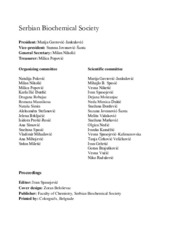Приказ основних података о документу
The capability of different TGF-β isoforms to induce EMT in human conjunctival epithelial cells
| dc.contributor | Spasojević, Ivan | |
| dc.creator | Rajić, Jovana | |
| dc.creator | Tolić, Anja | |
| dc.creator | Đorđević, Marija | |
| dc.creator | Đorđević, Miloš | |
| dc.creator | Mihailović, Mirjana | |
| dc.creator | Dinić, Svetlana | |
| dc.creator | Uskoković, Aleksandra | |
| dc.creator | Arambašić Jovanović, Jelena | |
| dc.creator | Poznanović, Goran | |
| dc.creator | Inić-Kanada, Aleksandra | |
| dc.creator | Barisani-Asenbauer, Talin | |
| dc.creator | Grdović, Nevena | |
| dc.creator | Vidaković, Melita | |
| dc.date.accessioned | 2023-05-26T09:43:16Z | |
| dc.date.available | 2023-05-26T09:43:16Z | |
| dc.date.issued | 2019 | |
| dc.identifier.isbn | 978-86-7220-101-7 | |
| dc.identifier.uri | http://radar.ibiss.bg.ac.rs/handle/123456789/5697 | |
| dc.description.abstract | Conjunctival fibrosis often emerges after infections, inflammations and mechanical stresses of the eye and when severe results in impaired vision. Recent data documented unavoidable role of epithelial to mesenchymal transition (EMT) in every fibrotic process including fibrosis-based eye conditions. The aim of this work was to establish whether human conjunctival epithelial (HCjE) cells are prone to EMT induction after prolonged treatment with well-known EMT inducers TGF-β proteins, and to test capabilities of TGF-β1, TGF-β2 and their combination to trigger this process. While TGF-β2 induced only alterations in cell-cell adhesion, TGF-β1 and combination of TGF-β proteins induced prominent change in cell morphology reflected in loss of cell-cell contacts, changes in shape from epithelial polygonal to spindle-like shape typical for mesenchymal phenotype and acquired ability to move. Statistically significant reduction of mRNA expression of epithelial marker genes (CDH1, OCLN, DSP) was observed in all treatment groups, while mRNA expression level of mesenchymal marker genes (CDH2, FN1, VIM) and EMT-related transcription factors (SNAI1, ZEB2, TWIST1) varied among treatment groups. TGF-β1 treatment induced the most pronounced increase in the level of mRNA of genes characteristic for mesenchymal phenotype that was accompanied with corresponding increase in protein level of two mesenchymal markers (CDH2, FN1), in parallel with decrease in protein expression of two epithelial markers (CDH1, DSP). To conclude, HCjE cells are prone to EMT induction and TGF-β1 possesses the highest potential for EMT induction in HCjE cells, suggesting that, in conditions of chronic inflammation, induction of EMT in conjunctival cells could contribute to fibrosis-related eye diseases. | sr |
| dc.language.iso | en | sr |
| dc.publisher | Belgrade: Faculty of Chemistry | sr |
| dc.relation | “Laura Bassi Centers of Expertise” program of the Austrian Federal Ministry of Economy through the Austrian Research Promotion Agency (FFG project number 822768) | sr |
| dc.relation | info:eu-repo/grantAgreement/MESTD/Basic Research (BR or ON)/173020/RS// | sr |
| dc.rights | openAccess | sr |
| dc.source | The 9th Conference of the Serbian Biochemical Society: Diversity in Biochemistry; 2019 Nov 14-16; Belgrade, Serbia | sr |
| dc.title | The capability of different TGF-β isoforms to induce EMT in human conjunctival epithelial cells | sr |
| dc.type | conferenceObject | sr |
| dc.rights.license | ARR | sr |
| dc.rights.holder | © 2019 by the Serbian Biochemical Society | sr |
| dc.description.other | Spasojević I, editor. The 9th Conference of the Serbian Biochemical Society: Diversity in Biochemistry; 2019 Nov 14-16; Belgrade, Serbia. Belgrade: Faculty of Chemistry; 2019. p. 159. | sr |
| dc.citation.spage | 159 | |
| dc.type.version | publishedVersion | sr |
| dc.identifier.cobiss | 280713228 | |
| dc.identifier.fulltext | https://radar.ibiss.bg.ac.rs/bitstream/id/13288/Proceedings_SBS_2019-159.pdf | |
| dc.citation.rank | M34 | |
| dc.identifier.rcub | https://hdl.handle.net/21.15107/rcub_ibiss_5697 |

